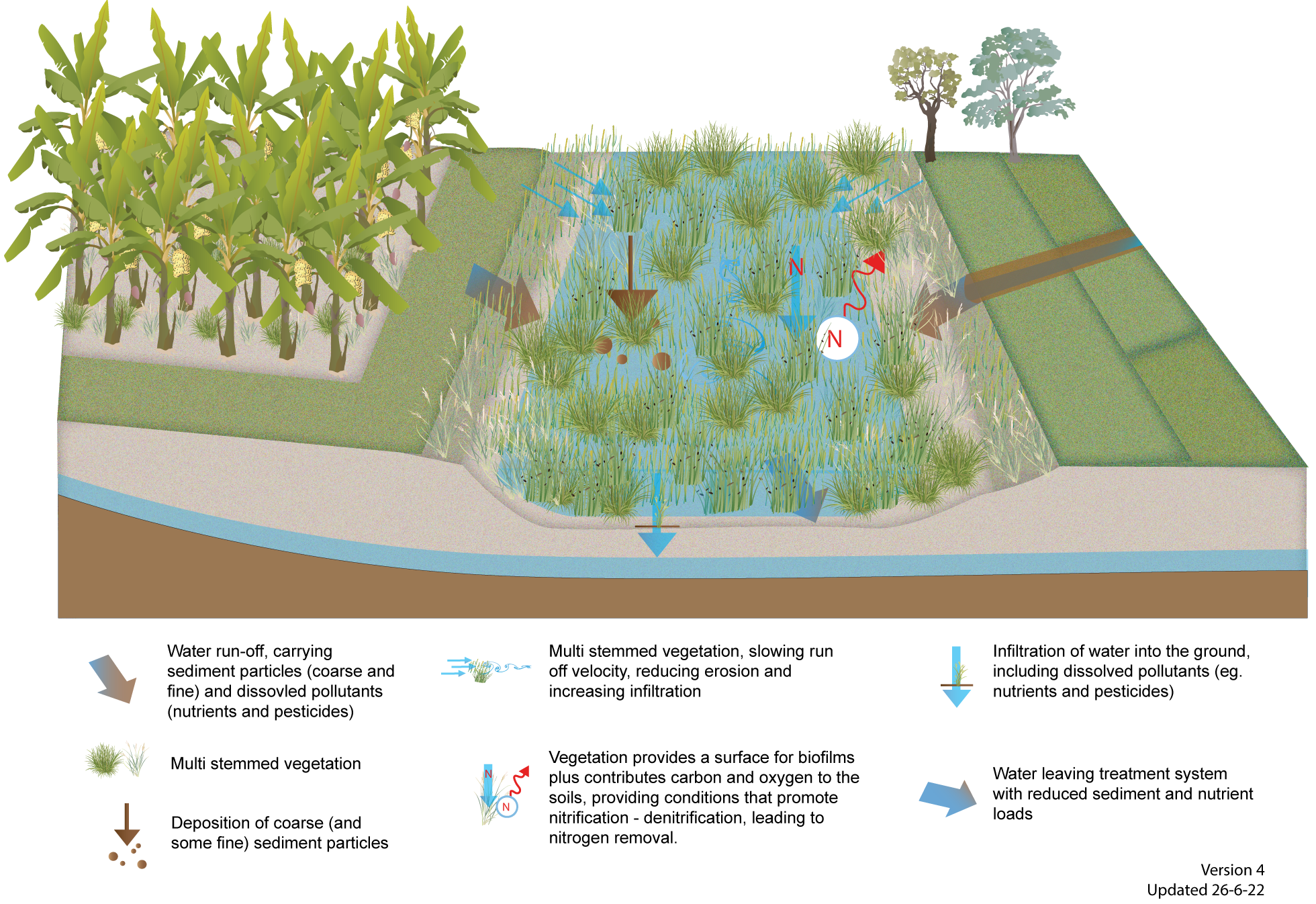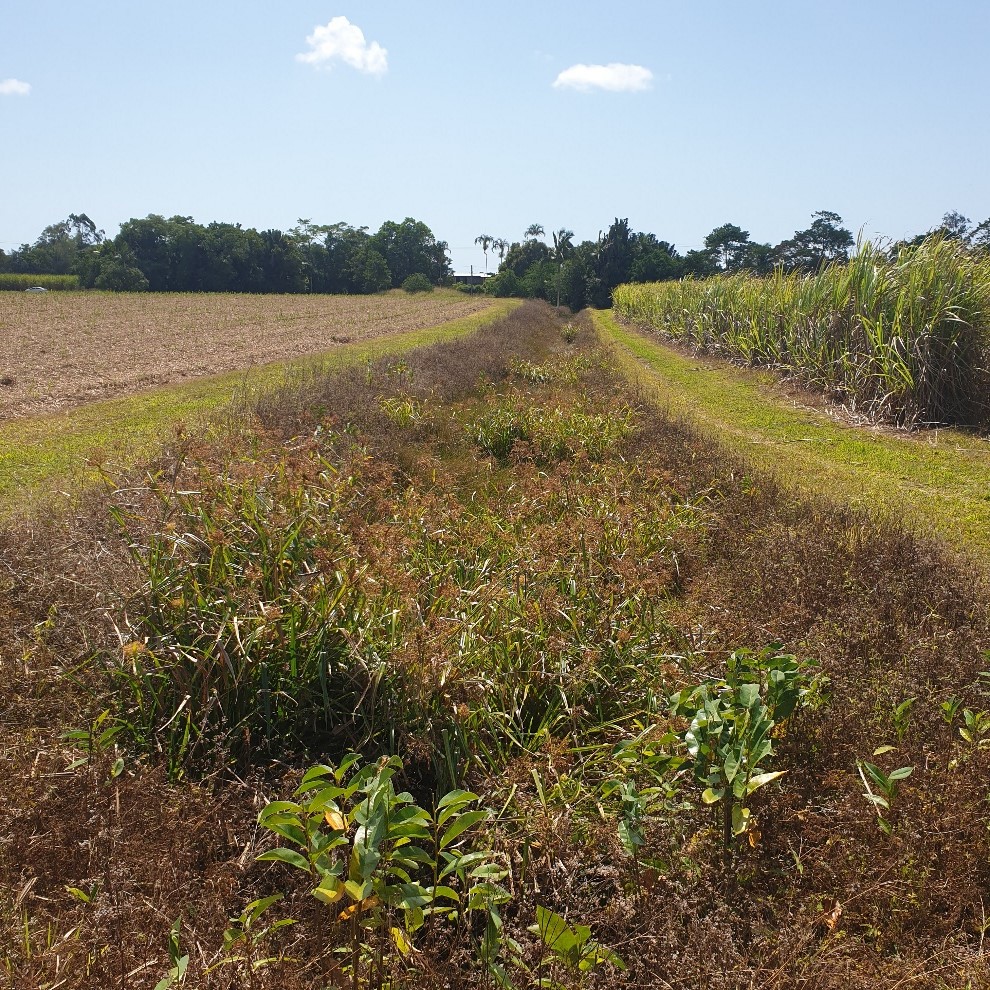|
|
Vegetated drainsVegetated drains — Planning and designSelect from the tabs below Site selectionExisting farm drains can be modified or managed to enhance treatment. Drains that receive regular, relatively slow water flows containing the target pollutant/s for treatment are likely to be the most cost-effective to modify and manage for water quality improvement. If a new vegetated drain is to be established for water quality improvement, it should be sited to receive run-off from the production area, minimising the amount of run-off from unfarmed areas, as the drain will work most effectively when it receives less water, with higher pollutant concentrations. New drains should be located where water naturally flows in the landscape to minimise erosion and constrain the flows using natural topography[1]. Refer to the Queensland Soil Conservation Guidelines for more information. Vegetated drains, for treatment purposes, are best suited to relatively small sub-catchments[4] and low-moderate slopes (<4%) to minimise velocity and maximise residence time. SizingVegetated drains should be wide enough to convey water flows at a velocity that does not cause erosion and facilitates sedimentation and denitrification (ideally between 0.04 m/s to 0.1m/s for frequent flows or less than 2m/sec for storm events)[5]. The size of the contributing catchment, slope, erodibility of soil, target pollutant and type and density of vegetation will influence water flows, conveyance and hence design[1]. The dense vegetation required for effective treatment will create roughness and friction, therefore the width of the drain and cross-sectional area will typically need to be larger than an unvegetated drain to convey the design flows. The length of a drain is likely to be constrained by the existing drain or production areas on a farm, but the length will influence the residence time of water within the drain. If the length is constrained, low weirs or check dams can be used to slow water and increase treatment[3][2]. A guide for calculating the dimensions of a drain can be found in the Queensland Soil Conservation Guidelines. DesignWide and shallow with either a flat bottom (trapezoidal shape) or shallow dish-shaped (parabolic) (Figure 4), to facilitate low velocities and uniform flow. A dish-shaped base is most like natural drainage lines and likely to be most effective at treatment as it minimises the risk of low-flows meandering and scouring out a channel in the base of the drain[1]. The depth and batter slope of the drain will influence the conveyance capacity and overall footprint of the drain and should be designed with consideration of maintenance (mown/slashed edges should have batters flatter than 1:3 vertical:horizontal)[1]. The width, depth and batters of a drain should also be designed so that flow velocity, water depth and batter gradient do not pose a safety hazard to people on the farm.
A two-stage ditch is an alternative design, where an existing drain is modified by adding ‘benches’ beside the original drain (Figure 5). These benches are densely vegetated and serve as small floodplains, becoming inundated during flow events thereby increasing residence time, plant uptake and denitrification[8] as well as providing increased drain capacity, to convey run-off.
Densely vegetated or has nodes/sections of dense vegetation for denitrification[5]. Densely vegetated drains have higher hydraulic roughness (i.e. create more friction) and therefore require a larger cross-sectional area to convey flows. The height and form of vegetation (e.g. spreading grass, tussocky reeds or shrubs) will influence the treatment performance of vegetated drains and should be selected based on the pollutant to be treated and the site conditions. If the water depth is greater than the height of the vegetation and if the vegetation readily lays flat during flows, the vegetation won't effectively decrease flow velocity thereby decreasing treatment efficacy[6]:
Relatively flat gradient to ensure consistent low flows (between 0.04-0.1m/s) to increase residence time yet maintain flow to avoid stagnation. Denitrification rates decrease when flows cease[2] and stagnant conditions are likely to favour transformation of organic nitrogen to ammonium rather than removal of nitrogen via denitrification[5]. Low weirs could also be installed within drains to increase residence time where water flows are likely to be too fast for effective treatment. Weirs maintain soil in a saturated state providing conditions suitable for denitrification and could also assist plant uptake[7]. Further guidance for designing drains can be found in the Queensland Soil Conservation Guidelines. DisclaimerIn addition to the standard disclaimer located at the bottom of the page, please note the content presented is based on published knowledge of treatment systems. Many of the treatment systems described have not been trialled in different regions or land uses in Queensland. The information will be updated as new trials are conducted and monitored. If you have any additional information on treatment systems or suggestions for additional technologies please contact us using the feedback link at the bottom of this page. References
Last updated: 24 May 2022 This page should be cited as: Department of Environment, Science and Innovation, Queensland (2022) Vegetated drains — Planning and design, WetlandInfo website, accessed 8 May 2025. Available at: https://wetlandinfo.des.qld.gov.au/wetlands/management/treatment-systems/for-agriculture/treatment-sys-nav-page/vegetated-drains/planning-design.html |

 — Department of the Environment, Tourism, Science and Innovation
— Department of the Environment, Tourism, Science and Innovation





